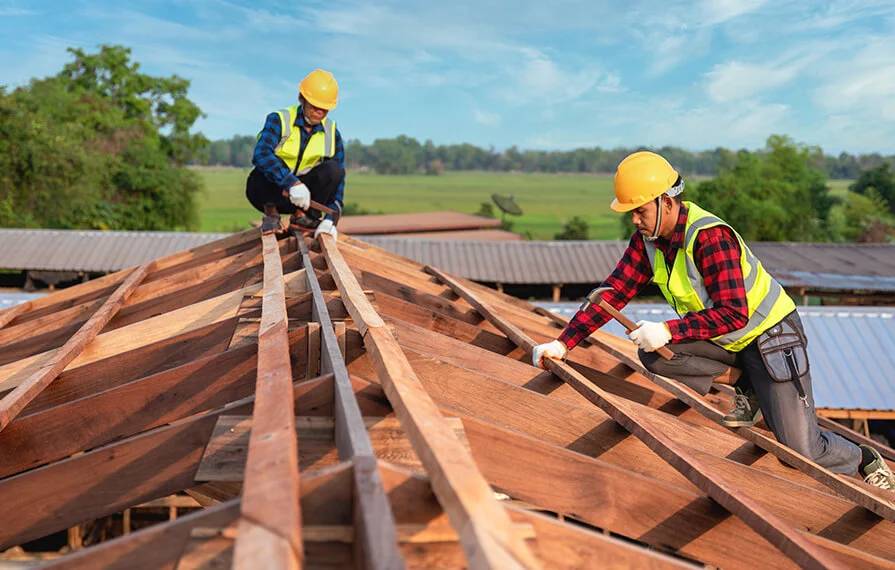Roofs are vital in safeguarding our homes from the elements providing shelter and protection. Although they might seem uncomplicated at first glance, the roof structure is a sophisticated system consisting of diverse components that harmoniously interact; for that reason, contracting a roofing specialist is essential. Ranging from the selection of roofing materials to the methods of installation, each element plays a role in determining a roof’s overall functionality and durability. In this discussion, we will explore the different aspects that make up the anatomy of a roof, including the importance of underlayment, the role of flashing, the significance of proper ventilation, and the necessity of a well-maintained gutter system. Understanding these key elements will enhance your knowledge of roofing systems and empower you to make informed decisions regarding the maintenance and care of your roof.
Roofing Materials
Roofing materials are crucial in providing protection and insulation for a building’s structure. Choosing a suitable roofing material is of utmost importance regarding sustainability and durability. Sustainable roofing materials have a minimal impact on the environment throughout their lifecycle. They are often made from recycled or renewable materials designed to minimize energy consumption and reduce waste. Durability is another crucial factor to consider when selecting roofing materials. A durable roof can withstand harsh weather conditions, such as heavy rain, strong winds, and extreme temperatures. Selecting materials with a prolonged lifespan and minimal maintenance is crucial for ensuring the roof’s durability and effectiveness.
Underlayment
With the foundation of suitable roofing material in place, the focus now shifts to the critical role of underlayment in ensuring a durable and protective roof. Underlayment is a crucial component of the roofing installation process, serving as a waterproofing technique that protects the structure from moisture and acts as a secondary barrier against leaks. It is typically installed directly on the roof deck before applying the roofing materials. Common types of underlayment include asphalt-saturated felt, synthetic materials like polyethylene or rubberized asphalt, and self-adhering membranes. The underlayment is designed to withstand harsh weather conditions and provide additional protection against water penetration. Proper underlayment installation prevents water damage and prolongs the roof’s lifespan.
Flashing
Flashing is an essential roofing system component to prevent water infiltration at vulnerable areas such as roof transitions, valleys, and penetrations. Proper roof flashing installation is crucial for maintaining the roof’s integrity and preventing water damage. There are several different types of roof flashing available, each serving a specific purpose:
– Step flashing: Used along roof transitions and walls, step flashing provides a watertight seal by overlapping shingles and diverting water away from vulnerable areas.
– Valley flashing: In roof valleys, valley flashing directs water away from the joint where two roof planes meet, preventing leaks.
– Vent pipe flashing: Placed around vent pipes and other roof penetrations, vent pipe flashing creates a waterproof seal to protect against water intrusion.
Ventilation
Proper ventilation is a fundamental aspect of a well-designed roofing system, as it plays a crucial role in maintaining a balanced and healthy indoor environment. Ventilation removes excess heat, moisture, and air pollutants from the attic space, preventing a range of issues such as mold, mildew, and deterioration of the roofing materials. Attic insulation is closely linked to ventilation, as it helps regulate temperature and reduce heat transfer between the attic and the living spaces below. Ridge vents are commonly used to provide adequate attic ventilation. These vents are installed along the roof ridge, allowing hot air to escape while drawing in cooler air through the soffits. This continuous airflow helps maintain optimal conditions within the attic, promoting energy efficiency and prolonging the roofing system’s lifespan.
Gutters
Gutters are an essential component of a roofing system, designed to efficiently collect and redirect rainwater away from the structure, preventing water damage and maintaining the integrity of the building. Proper gutter installation and maintenance are crucial to ensure their optimal functionality. Here are three key points to consider:
- Gutter installation:
– Positioning: Install gutters with a gentle slope to facilitate unrestricted water flow towards the downspouts.
– Size: Choosing the correct gutter size based on the roof’s surface area and average rainfall is essential for effective water management.
– Materials: Selecting durable materials, such as aluminum or steel, can enhance the longevity of the gutter system.
- Gutter maintenance:
– Regular cleaning: Leaves, debris, and dirt can clog gutters, leading to water overflow and damage. Regular cleaning helps prevent blockages.
– Inspections: Periodic inspections allow for early detection of leaks or sagging gutters, enabling timely repairs.
– Repair and resealing: Any damaged sections or joints should be promptly repaired and resealed to maintain the efficiency of the gutter system.
